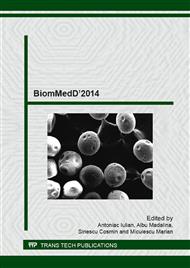[1]
K. Chenf, K.H. Chiu, Stamping formability of pure titanium sheets, J. Mater. Process. Tech. 170 (2005) 181-186.
Google Scholar
[2]
T. Ohwue, T. Shindo, T. Hayashi, Square shell deep drawability of commercially pure titanium sheet, Nippon Steel Tech. Rep. 85 (2002) 125-128.
Google Scholar
[3]
G.G. Yapici, I. Karaman, H.J. Maier, Mechanical flow anisotropy in severely deformed pure titanium, Mat. Sci. Eng. A 434 (2006) 294-302.
DOI: 10.1016/j.msea.2006.06.082
Google Scholar
[4]
G. Lutjering, J.C. Williams, Titanium, Springer-Verlag, Berlin, (2003).
Google Scholar
[5]
X. Tan, H. Gu, S. Zhang, C. Laird, Loading mode dependence of deformation microstructure in a high-purity titanium single crystal oriented for difficult glide, Mat. Sci. Eng. A 189 (1994) 77-84.
DOI: 10.1016/0921-5093(94)90403-0
Google Scholar
[6]
V.V. Stolyarov, Y.T. Zhu, I.V. Alexandrov, T.C. Lowe, R.Z. Valiev, Influence of ECAP routes on the microstructure and properties of pure Ti, Mat. Sci. Eng. A 299 (2001) 59-67.
DOI: 10.1016/s0921-5093(00)01411-8
Google Scholar
[7]
W. Zhao, W. Zhang, J. Guo, B. Wang, K. Lu, Microstructure evolution and tensile properties of pure Ti subjected to rapidly heating and quenching, J. Mater. Sci. Technol. 22 (2006) 190-194.
Google Scholar
[8]
S.S. Rocha, G.L. Abado, G.E.P. Hendriques, M.A. de Arruda Nobilo, Vickers hardness of cast commercially pure titanium and Ti-6Al-4V alloy submitted to heat treatments. Braz. Dent. J. 17 (2006) 126-129.
DOI: 10.1590/s0103-64402006000200008
Google Scholar
[9]
N. Poondla, T.S. Srivatsan, A. Patnaik, M. Petraroli, A study of the microstructure and hardness of two titanium alloys commercially pure and Ti-6Al-4V, J. Alloys. Compd. 486 (2009) 162-167.
DOI: 10.1016/j.jallcom.2009.06.172
Google Scholar
[10]
M.P. Neuapne, Y.K. Kim, I.I. Song Park, M.H. Lee, T.S. Bae, Characterization of surface oxide films and cell toxicity evaluations with a quenched titanium surface, Metals Mater. Int. 14 (2008) 443-448.
DOI: 10.3365/met.mat.2008.08.443
Google Scholar
[11]
T. Yamane, J. Ueda, Mechanical properties of commercial pure titanium at high temperature, Jap. Inst. Metals. Trans. 7 (1966) 91-95.
DOI: 10.2320/matertrans1960.7.91
Google Scholar
[12]
Y.B. Chun, S.L. Yu, S.L. Semiatin, S.K. Wang, Effect of deformation twinning on microstructure and texture evolution during cold rolling of CP-titanium. Mat. Sci. Eng. A 398 (2005) 209-219.
DOI: 10.1016/j.msea.2005.03.019
Google Scholar
[13]
V.V. Stolyarov, Y.E. Beigelzimer, D.V. Orlov, R.Z. Valiev, Refinement of micro-structure and mechanical properties of titanium processed by twist extrusion and subsequent rolling, Phys. Metals. Metallogr. 99 (2005) 204-211.
Google Scholar
[14]
R. Boyer, G. Welsch, and E. W. Collings, Materials Properties Handbook: Titanium Alloys eds. ASM International, Materials Park, OH, (1994).
Google Scholar


